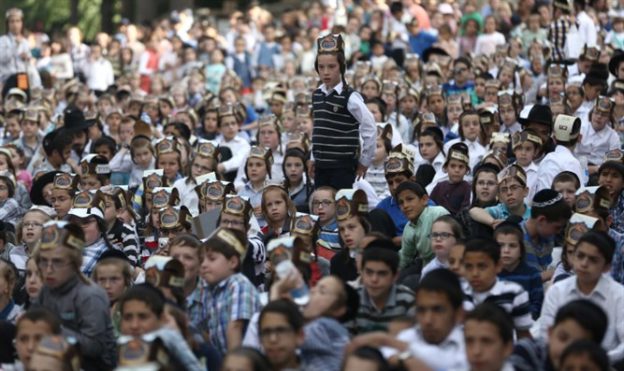An article of mine on the disconnect between contemporary society’s understanding of abortion and that of Judaism was published by the Jewish Telegraphic Agency and can be read here.


An article of mine on the disconnect between contemporary society’s understanding of abortion and that of Judaism was published by the Jewish Telegraphic Agency and can be read here.

A Fox opinion piece of mine about non-Jewish public figures who have the courage to speak out about anti-Semitism can be read here.

A sampling of recent weeks’ gun news:
An estimated 1.4 million Americans have died in all the wars in U.S. history, going back to the American Revolution. Approximately the same number of civilian citizens have died as a result of gun shootings – since 1970.
Gun deaths in the U.S. aren’t the result of murders alone, but also of accidents and suicides. In 2016, while 14,415 people died in gun homicides, 22,938 people used firearms to commit suicide.
New Jersey Senator and Democratic presidential candidate (and who isn’t one these days?) Corey Booker has proposed a radical plan to reduce gun violence. It includes a ban on assault weapons, the closing of loopholes that allow domestic abusers to buy guns and, most ambitiously, the creation of a national licensing program that would require prospective gun buyers to undergo extensive background checks by the F.B.I., including fingerprinting and interviews, in order to obtain a renewable five-year gun license.
Sounds draconian. But a 2015 study showed that after Connecticut introduced a similar gun licensing program, gun deaths in the state dropped by 40%.
And it wouldn’t be as draconian – or, at least, not as apoplexy-inducing in some circles – as… repealing the Second Amendment.
Just reading that phrase, in those circles, evokes images of governmental tyranny and persecution of citizens deprived of the means of resistance. And outrage at the unthinkable violence such a move would inflict on a heretofore Constitutional right.
But the Constitution isn’t beyond change – the Second Amendment, after all, is itself an amendment to the foundational document. And if anyone really thinks that owning a gun (or 1000 of them) will protect him from the wrath of a gone-insane, malevolent federal force, with arsenals of tanks and rockets, the crazed fantasist shouldn’t be allowed to own a penknife.
To be sure, repealing the Second Amendment is a long shot. But it’s not an outlandish one. Former Supreme Court Justice John Paul Stevens favors it, and harshly criticized the landmark 2008 Supreme Court District of Columbia v. Heller decision that enshrined an individual’s Constitutional right to keep a gun. Mr. Stevens wrote that “the text of the Second Amendment unambiguously explains” that it was meant to allow for “a well regulated militia,” and was intended only to prevent Congress from disarming state militias and infringing on the sovereignty of the states, not to grant individuals a right to gun ownership.
Another personage, with a similar surname, the conservative columnist Bret Stephens (who, not long ago, helped bring his employer, the New York Times, to apologize, and apologize and apologize, for its inclusion of a cartoon with anti-Semitic imagery), has also advocated for the repeal of the Second Amendment, calling it “a legal regime that most of the developed world rightly considers nuts.”
Washington Times columnist Cheryl Chumley begs to differ, contending that the Second Amendment is verily divine, based, as she contends, “on rights given individuals from G-d, not government.”
How so? Because, Ms. Chumley explains, the amendment “restricts government’s ability to strip citizens from their G-d-given rights to self-protection.”
Indeed, many of us do feel more secure owning a firearm, and guns have been used to protect innocent people. But there are less lethal instruments – like TASERs or pepper spray – that can also be used to defend oneself against an assailant, but which are unsuitable for committing suicide or for the sort of school and synagogue mass shootings that have become, Rachmana litzlan, almost commonplace these days.
Although it’s unarguable that fewer guns in society will mean fewer gun deaths, there may be no point in advocating repeal of the Second Amendment. So far, not even the amount of gun violence that occurs daily has inspired anything more than an op-ed or two supporting such a radical move.
But it’s alluring (and I speak, as always in this space, for myself alone, not Agudath Israel of America) to imagine an America with a mere fraction of its current 393 million civilian-owned firearms.
© 2019 Hamodia

An article of mine in the Forward about the role of Orthodox anti-vaxxers in the measles epidemic can be read here

On the first day of Pesach, Michigan Representative Rashida Tlaib offered the “Jewish sisters and brothers” among her constituents Passover greetings, accompanied by a graphic that included two fluffy loaves of bread. A similar faux pas (perhaps, here, articulating the French should-be-silent “s”) was part of the British Labor Party’s seasonal greeting as well.
Ms. Tlaib’s ignorance of one of the most important and widely-recognized elements of Pesach observance nicely paralleled her similar unawareness of the history of the Jews and Eretz Yisrael.
Her unbridled support of the “Palestinian cause” reveals an obliviousness to the uninterrupted Jewish presence over millennia in the land that today comprises the state of Israel, and the even more trenchant fact that the Jews who were expelled from the land after the destruction of the Second Beis Hamikdash, and their descendants over all the subsequent generations, have turned daily to Yerushalayim in prayer and pined for a return to their ancestral homeland.
Although Ms. Tlaib hasn’t publicly expressed an explicit hope for an end to the Jewish presence in the Jewish land, she openly supports the Boycott, Divestment and Sanctions (BDS) movement against Israel, advocates for a “Palestinian right of return” and backs a “one-state solution” – by which she presumably means (based on that “right of return” for all the descendants of all the emigrants from Partition-era Palestine) the transition of Israel, chalilah, into a 22nd Arab country.
The offensiveness of her infamous comment back in January about Senators Marco Rubio and Jim Risch – that, because of their opposition to BDS, they “forgot what country they represent” – has now been complemented by the craziness of her reaction to a report on the most recent conflict between Hamas and Israel in Gaza.
To be specific, to a headline in The New York Times summing up the violent happenings. The headline read: “Gaza militants fire 250 rockets, and Israel responds with airstrikes.”
The 250 rockets eventually became more than 700, and caused scores of Israeli civilian casualties, including three deaths – one of them a Bedouin father of seven; another, a 21-year-old chareidi father of a one-year-old. But, at the time of the Times’ report, the headline was an accurate, straightforward description of events.
Representative Tlaib, though, was outraged. “When will the world stop dehumanizing our Palestinian people who just want to be free?” she tweeted. “Headlines like this & framing it in this way just feeds into the continued lack of responsibility on Israel who unjustly oppress & target Palestinian children and families.”
Wha?
The headline just stated the bald facts of the conflict: terrorists shot hundreds of rockets at Israeli civilians and Israel ended the onslaught by attacking Hamas military targets from the air. Perhaps Ms. Tlaib would have preferred the chronology to be reversed, with Israeli attacks followed by Hamas retaliation. But time, alas, proceeds in only one direction.
And if the Congresswoman meant to reference the four Palestinian protesters at the border fence who were killed by Israeli forces the previous Friday, well, Palestinian violence at “peaceful protests” is legend. And those killings were preceded by the shooting of two Israeli soldiers there. That pesky arrow of time again.
The Congresswoman might also be reminded that Israel evacuated Gaza in 2005, relocating over 10,000 Jews, ethnically cleansing the region; and that the local residents, “who just want to be free,” freely elected a terrorist organization to rule them – which is what has directly resulted in their current deprivation and suffering.
If Ms. Tlaib – and we might well add her colleague Minnesota Representative Ilhan Omar, who likewise wished Jews a “happy Passover” – really wanted to gain respect from Jewish constituents and other American Jews, they might have issued a full-throated condemnation of Hamas’ most recent attempt to terrorize and murder Israeli civilians. And, for that matter, of Hamas’ general embrace of terrorism, incitement of the populace under its control and sworn goal of erasing Israel from the map.
Shia Muslim Imam and President of the Islamic Association of South Australia Mohamad Tawhidi did precisely that. And he went on to call out Mss. Tlaib and Omar for their own lack of outrage over Hamas’ terrorism.
Earlier this year, while paying his respects to Holocaust victims at Auschwitz, the imam was even blunter about the two Congresswomen, criticizing them as “absolute frauds and Islamists” who “promote hatred against the Jewish people.”
I don’t claim to know what lies in the heart of either woman. But I know what seems absent from both their heads: a recognition of the facts of history, both ancient and current.
As absent, it would seem, as leavened bread in observant Jewish homes on Pesach.
© 2019 Hamodia

The third one, at least for me, did the trick. The third New York Times apology, that is.
The venerated publication, as most readers know by now, not long ago published an overtly anti-Semitic cartoon in its International Edition.
It depicted a guide dog with a face resembling Benjamin Netanyahu leading a blind, grotesquely overweight Donald Trump wearing dark glasses and a black yarmulke. A magen Dovid dangled from the dog’s collar.
When the cartoon was shared online, it was met with broad outrage. With its Jewish symbols and theme of an Israeli Prime Minister leading an unsighted American president, its Der Stürmer-keit was unmistakable. The Times issued a quick but brief apology – #1 – and then, after a wide and loud public outcry, a more comprehensive one – #2.
Then, last week, came #3, in the form of an unusual “Editorial Board” lead editorial.
When it appeared, Agudath Israel of America had been poised to issue a strongly worded statement about the cartoon, and a subsequent one depicting Mr. Netanyahu descending a mountain carrying a tablet featuring the Israeli flag, taking a picture of himself with a “selfie-stick.”
The ready-to-release statement pointedly suggested that The Times take a selfie of its own, and examine it closely and critically. Since the paper essentially did that, the statement was quashed.
The April 30 Editorial Board offering, titled “A Rising Tide of Anti-Semitism” and representing the view of the highest echelon of the paper, admitted, inter alia, that the first cartoon was “appalling” and that “an obviously bigoted cartoon in a mainstream publication is evidence of a profound danger – not only of anti-Semitism but of numbness to its creep, to the insidious way this ancient, enduring prejudice is once again working itself into public view and common conversation.” [Emphasis mine.] Indeed.
The editorial went on to list recent acts of violent anti-Semitism, to acknowledge that “anti-Zionism can clearly serve as a cover for anti-Semitism,” and to bemoan the fact that “In the 1930s and the 1940s, The Times was largely silent as anti-Semitism rose up and bathed the world in blood. That failure still haunts this newspaper.”
The editorial board statement also admitted that “apologies are important but the deeper obligation of The Times is to focus on leading through unblinking journalism and the clear editorial expression of its values.” And that, while “society in recent years has shown healthy signs of increased sensitivity to other forms of bigotry… somehow anti-Semitism can often still be dismissed as a disease gnawing only at the fringes of society. That is a dangerous mistake. As recent events have shown, it is a very mainstream problem.”
It is a problem that The Times, unfortunately, has helped feed, with its reportage, editorials and op-eds over more recent years, from misrepresentation of the 1991 Crown Heights riots to harsh criticism of Israeli actions of self-defense to repeated, unwarranted criticism of the Orthodox Jewish community.
Late last year, a group of representatives from Agudath Israel and the Orthodox Union met with The Times’ editorial page editor with the express purpose of trying to call attention to the dearth of Orthodox views on the paper’s op-ed page – a wrong compounded by the frequent criticism of the community that appears there.
The editor, who had at first tried to rebuff the charge, did some research and admitted the problem. And he pledged to be more open to Orthodox views.
So far, slim pickings. Although an opinion piece I submitted about Chanukah was published by The Times online, it was a “thought piece,” not a presentation of a position on a contemporary issue. And while ideas for examples of the latter, on topics like yeshivah education and the measles outbreak, to be written by qualified, credentialed members of our community were put forth, they were not accepted.
Does The Times recognize that part of the “creep” of subtle anti-Semitism involves negative coverage of the most recognizably Jewish of Jews, and the vacuum of Orthodox views on its op-ed page? Or has “numbness” set in there too?
It’s easy, even for an inveterate optimist like me, to be pessimistic. After all, there hasn’t been much positive movement to date, at least not visibly so.
But the willingness of the Old Grey Lady to publicly and prominently confess to sins both distant and present, and her pledge to be alert to the “insidious way this ancient, enduring prejudice” of Jew-hatred “creeps” into societal (and journalistic) discourse, and to the danger of “numbness” to that creep, leaves some hope in my heart.
Time, as the truism has it, will tell.
© 2019 Hamodia

A piece I wrote for Fox News about “moments of silence” in public schools can be read here.

An Open Letter to Anat Hoffman
Dear Ms. Hoffman,
Many years ago, we shared a stage for a panel discussion about Israel and Judaism. But you are a well-known public figure and have appeared in countless venues to promote the feminist cause of your group “Women of the Wall,” so I hardly expect you to remember our fleeting interaction.
What you may be more familiar with is my written criticism of your goals and your group, since some of it has appeared in secular media both here in America and in Israel. I want to assure you that it was not intended as a personal attack, but was rather a battle undertaken in the arena of ideas. You have argued that the Kosel Maaravi should be a place where nontraditional public and vocal services should take place, even if such things offend those who most frequent the site.
And I have maintained that the hanhagah in place since the Wall was captured in 1967, effectively enshrining normative Orthodox practice as the standard for congregational prayer at the Kosel, should remain unchanged.
I am writing to you publicly now because of the results of the most recent Israeli elections. As you know, and likely bemoan, the two chareidi parties, Yahadut HaTorah and Shas, made unexpectedly strong showings. Their equally shared 16 Knesset seats represent a nearly 25 percent increase from their previous electoral representation. And together, they now constitute the largest Knesset faction in the government coalition after Likud, with more than three times the seats as the next most successful party.
That being the case, the chareidi parties are virtually assured to be part of Israel’s new government. That observation is not made to rub salt in any wounds, chas v’shalom, but rather as a prelude to a plea.
Realistically speaking, political machinations are not likely to change the longstanding status quo at the Kosel in the foreseeable future. And even if the Israeli courts are successfully enlisted to support the cause of dismantling the traditional public prayer custom at the site, the Knesset may be able to use its legislative power to circumvent such efforts.
In any event, the change for which you advocate is not likely in the cards for now.
And so, my plea:
Might you consider, in light of that reality, “demilitarizing” the Kosel, and putting your formidable talents and energies into truly important feminist causes, things like advocacy on behalf of equal pay for equal work and effective anti-harassment laws?
For, as you know, bringing loud nontraditional services to the revered site, as you have regularly done, only serves to cause strife. I make no excuses for anyone who berates another Jew, or so much as throws a crumpled piece of paper at her or him, much less for someone who assaults another. Hotheads exist in every group and should be tolerated in none.
But you know that your group’s actions will always meet with obnoxious reactions. Indeed, you have counted on it, making sure that when you arrive at the Kosel there are cameras and media in tow to capture whatever ugliness might result.
Provoking another Jew to overreact may not be as wrong as the overreaction itself. But it, too, is wrong.
And so, just think of what it might be like were you to seek changes to truly improve the lot of women in Israel, rather than a crusade whose only ultimate yield is strife.
Think of what it would be like to join the women who daven at the Kosel regularly with the sole goal of pouring out their hearts to Hashem. What an accomplishment it would be to make the Kosel plaza great again. A place of peace again.
You know that no one – traditional or nontraditional, Jew or non-Jew – has ever been prevented from worshipping there as an individual, and that the great majority of those who flock to the site regularly are Orthodox Jews, who want there to be a mechitzah near the Wall, and want audible public tefillah there to respect the norms born of centuries, indeed millennia, of Jewish tradition.
And you know, further, that until you launched your quest, the Kotel plaza was a place of uninterrupted amity – a Jewish societal oasis, probably the only place on earth where Jews of different religious stripes prayed sincerely side by side.
Might you consider returning it to that, every day of the year?
You and your followers can, as always, promote your religious or societal ideals in any private venue. But please give thought to the good will that you would be showing, and inspiring, were you to decide to make the Kosel once again an undisturbed place of Jewish comity and peace.
Thank you,
Avi Shafran
© 2019 Hamodia

An article I wrote about the growth of the Orthodox community in Israel and in the U.S. appeared at Fox News today, and can be read here.

I often feel terribly pampered. Especially when I think of my parents’ generation.
At the age when my father, z”l, and several others from the Novardok Yeshiva in Vilna were captured for being Polish bnei yeshivah and banished by the Soviets to Siberia, I was being captured by a teacher for some prank and banished to the principal’s office. When he was trying to avoid working on Shabbos as his taskmasters demanded, I was busy trying to avoid the homework my teachers demanded.
When he was moser nefesh finding opportunities to study Torah while working in the frozen taiga, my mesirus nefesh consisted of getting out of bed early in the morning for davening. Where he struggled to survive, my only struggle was with the mundane challenges of adolescence. Pondering our respective age-tagged challenges has lent me perspective.
And so, while I help prepare the house for Pesach, pausing to rest each year a bit more frequently than the previous one, thoughts of my father’s first Pesach in Siberia arrive in my head.
In his slim memoir, “Fire, Ice, Air,” he describes how Pesach was on the minds of the young men and their Rebbi, Rav Leib Nekritz, zt”l, as soon as they arrived in Siberia in the summer of 1941. While laboring in the fields, they pocketed a few wheat kernels here and there, later placing them in a special bag, which they carefully hid. This was, of course, against the rules and dangerous. But the Communist credo, after all, was “from each according to his ability, to each according to his needs,” and so they were really only being good Marxists. They had needs, after all, like matzah shemurah.
Toward the end of the frigid winter, they retrieved their stash and ground the wheat into coarse, dark flour.
They then dismantled a clock and fitted its gears to a whittled piece of wood, fashioning an approximation of the cleated rolling pin traditionally used to perforate matzos to ensure their thorough baking. In the middle of the night, the exiles came together in a hut with an oven, which they fired up for two hours to make it kosher l’Pesach before baking their matzos.
And on Pesach night they fulfilled, to the extent they could, the mitzvah of achilas matzah.
Perspective is provided me too by the wartime Pesach experience of, l’havdil bein chaim l’chaim, my wife’s father, Reb Yisroel Yitzchok Cohen, may he be well. In his own memoir, “Destined to Survive,” he describes how, in the Dachau satellite camp where he was interned, there was no way to procure matzah. All the same, he was determined to have the Pesach he could. In the dark of the barracks on the leil shimurim, he suggested to a friend that they recite parts of the Haggadah they knew by heart.
As they quietly chanted Mah Nishtanah, other inmates protested. “What are you crazy Chassidim doing?” they asked. “Do you have matzos, do you have wine and food for a Seder? Sheer stupidity!”
My shver responded that he and his friend were fulfilling a mitzvah d’Oraysa – and that no one could know if their “Seder” is less meritorious in the eyes of Heaven than those of Jews in places of freedom and plenty.
We in such places can glean much from the Pesachim of those two members – and so many other men and women – of the Jewish “greatest generation.”
A passuk cited in the Haggadah elicited a novel thought from Rav Avrohom, the first Rebbe of Slonim. The Torah commands us to eat matzah on Pesach, “so that you remember the day of your leaving Mitzrayim all the days of your life.”
Commented the Slonimer Rebbe: “When recounting Yetzias Mitzrayim, one should remember, too, ‘all the days’ of his own life – the miracles and wonders that Hashem performed for him throughout…”
Those who, baruch Hashem, emerged from the Holocaust and merited to see children, grandchildren and great-grandchildren, naturally do that. But the rest of us, too, have experienced our own “miracles and wonders.” We may not recognize all of the Divine guidance and chassadim with which we were blessed. But that reflects only our obliviousness. At the Seder, when we recount Hakadosh Baruch Hu’s kindnesses to our ancestors, it is a time, too, to look back at our own personal histories and appreciate the personal gifts we’ve been given.
And should that prove a challenge, we might begin by reflecting on what some Jews a bit older than we had to endure not so very long ago.
© 2019 Hamodia